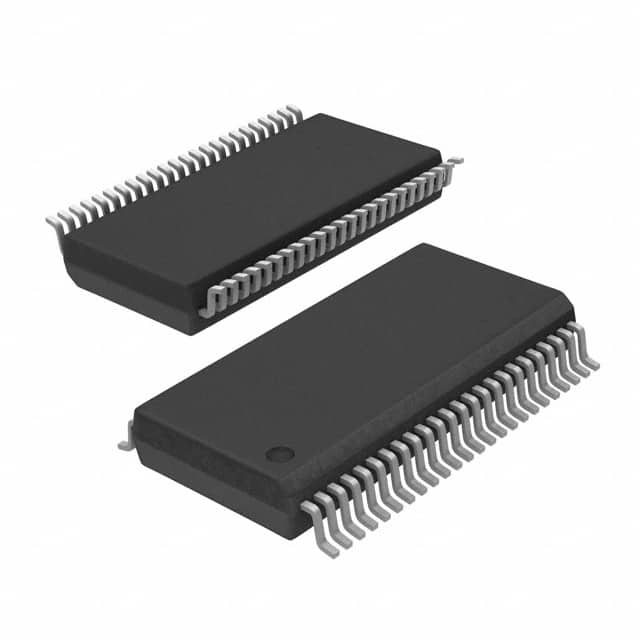Xem thông số kỹ thuật để biết chi tiết sản phẩm.

SN74ALVC16244ADLR
Product Overview
- Category: Integrated Circuit (IC)
- Use: Buffer/Driver
- Characteristics: High-speed, low-voltage, 16-bit bus transceiver
- Package: TSSOP (Thin Shrink Small Outline Package)
- Essence: Transmits and receives data between different parts of a digital system
- Packaging/Quantity: Tape and Reel, 2500 units per reel
Specifications
- Logic Family: ALVC (Advanced Low-Voltage CMOS)
- Number of Bits: 16
- Input Voltage Range: 1.65V to 3.6V
- Output Voltage Range: 1.65V to 3.6V
- Propagation Delay: 2.5ns (max)
- Output Drive Strength: ±24mA
- Operating Temperature Range: -40°C to +85°C
Detailed Pin Configuration
The SN74ALVC16244ADLR has a total of 48 pins, which are divided into four groups:
- Group A (pins 1-12): Data Inputs/Outputs (D1-D16)
- Group B (pins 13-24): Enable Inputs (G1-G4)
- Group C (pins 25-36): Output Enable Inputs (OE1-OE4)
- Group D (pins 37-48): Supply Voltage and Ground (VCC, GND)
Functional Features
- Bidirectional Data Transmission: Allows data to be sent and received on the same set of pins.
- Non-Inverting Outputs: The output signals have the same logic level as the input signals.
- High-Speed Operation: Enables fast data transfer between different parts of a digital system.
- Low-Voltage Operation: Supports operation at lower supply voltages, reducing power consumption.
Advantages and Disadvantages
Advantages: - High-speed operation allows for efficient data transfer. - Low-voltage operation reduces power consumption. - Bidirectional data transmission simplifies system design.
Disadvantages: - Limited number of bits (16) may not be suitable for applications requiring larger data buses. - TSSOP package may be challenging to solder for some users.
Working Principles
The SN74ALVC16244ADLR is a 16-bit bus transceiver that enables bidirectional data transmission between different parts of a digital system. It operates using the ALVC logic family, which allows for high-speed operation at low supply voltages. The inputs and outputs are non-inverting, meaning that the output signals have the same logic level as the input signals.
The transceiver has separate enable inputs (G1-G4) and output enable inputs (OE1-OE4), which control the direction of data flow and the tri-state outputs, respectively. When the enable inputs are active, the transceiver allows data to be transmitted from the A side to the B side or vice versa. When the output enable inputs are active, the outputs are enabled and can drive the connected circuitry.
Detailed Application Field Plans
The SN74ALVC16244ADLR is commonly used in various digital systems where bidirectional data transmission is required. Some specific application fields include:
- Microprocessors and Microcontrollers: The transceiver facilitates communication between the processor and other peripherals, such as memory modules or input/output devices.
- Communication Systems: It can be used in networking equipment, routers, and switches to transmit data between different network interfaces.
- Industrial Automation: The transceiver enables data exchange between various control units and sensors/actuators in industrial automation systems.
- Automotive Electronics: It finds applications in automotive control systems, allowing data transfer between different electronic modules within a vehicle.
Detailed and Complete Alternative Models
- SN74ALVC16244DGGR: Similar to SN74ALVC16244ADLR, but in a different package (TSSOP-48).
- MC74LVX16244DTR2G: 16-bit bus transceiver with similar characteristics, but operates at a higher voltage range (2V to 3.6V).
- 74LVC16244A: Another 16-bit bus transceiver from a different manufacturer, offering similar functionality and characteristics.
These alternative models can be considered based on specific requirements, availability, and compatibility with the target system.
Word count: 526 words
Liệt kê 10 câu hỏi và câu trả lời thường gặp liên quan đến ứng dụng SN74ALVC16244ADLR trong giải pháp kỹ thuật
Sure! Here are 10 common questions and answers related to the application of SN74ALVC16244ADLR in technical solutions:
Q: What is SN74ALVC16244ADLR? A: SN74ALVC16244ADLR is a 16-bit buffer/driver with 3-state outputs, commonly used for signal buffering and level shifting in digital circuits.
Q: What is the operating voltage range of SN74ALVC16244ADLR? A: The operating voltage range of SN74ALVC16244ADLR is typically between 1.65V and 3.6V.
Q: What is the maximum output current that SN74ALVC16244ADLR can drive? A: SN74ALVC16244ADLR can drive up to 24mA of current per output pin.
Q: Can SN74ALVC16244ADLR be used for bidirectional communication? A: No, SN74ALVC16244ADLR is a unidirectional buffer/driver and does not support bidirectional communication.
Q: How many 3-state outputs does SN74ALVC16244ADLR have? A: SN74ALVC16244ADLR has 16 3-state outputs, each corresponding to one input pin.
Q: What is the propagation delay of SN74ALVC16244ADLR? A: The propagation delay of SN74ALVC16244ADLR is typically around 3.8ns.
Q: Can SN74ALVC16244ADLR be used in high-speed applications? A: Yes, SN74ALVC16244ADLR is designed for high-speed operation and can be used in applications with fast switching speeds.
Q: Does SN74ALVC16244ADLR have built-in ESD protection? A: Yes, SN74ALVC16244ADLR has built-in ESD protection on all inputs and outputs.
Q: Can SN74ALVC16244ADLR be used in automotive applications? A: Yes, SN74ALVC16244ADLR is qualified for automotive applications and meets the necessary standards.
Q: What is the package type of SN74ALVC16244ADLR? A: SN74ALVC16244ADLR is available in a TSSOP (Thin Shrink Small Outline Package) package with 48 pins.
Please note that these answers are general and may vary depending on the specific datasheet and manufacturer's specifications.

